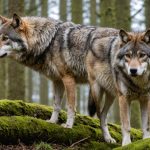Assessing the Feasibility of Wolf Reintroduction in the UK
Understanding the wolf reintroduction UK initiative begins with examining current wildlife management practices. The UK focuses heavily on conserving native species and controlling invasive populations, but large carnivores like wolves have been absent for centuries. This absence has led to shaped ecosystems and management priorities around prey animals such as deer.
Evaluating habitat suitability is a critical step in the feasibility analysis. While the UK features scattered woodlands and rural landscapes that could potentially support wolves, widespread urbanization and land fragmentation present considerable challenges. Experts highlight that suitable continuous habitats, necessary for sustaining packs, are currently limited but could improve through ecological restoration efforts.
In the same genre : What are the conservation success stories in the UK?
Expert perspectives generally acknowledge both the ecological benefits and practical hurdles of reintroducing wolves. Many advocate for detailed studies incorporating social, ecological, and economic factors before any action. They emphasize that wolves could help restore natural processes and balance deer populations but caution that acceptance by local communities and landowners is vital.
In sum, assessing the wolf reintroduction UK concept requires balancing ecological restoration goals with habitat realities and stakeholder engagement. Only thorough, multi-disciplinary feasibility analyses can pave the way for responsible and successful reintroduction projects.
Have you seen this : What new policies are being implemented to protect UK animal habitats?
Ecological and Environmental Impacts of Wolf Reintroduction
Wolf reintroduction is more than a simple wildlife decision; it reshapes ecosystems in profound ways.
Scientific studies consistently highlight the ecological impact of wolf reintroduction, particularly how these apex predators regulate prey species like deer. By controlling deer populations, wolves help prevent overgrazing, which can allow forest undergrowth and vegetation to recover. This recovery supports greater species diversity, fostering biodiversity and healthier habitats.
Environmental assessments also reveal potential risks. For instance, unchecked wolf populations might disrupt local farming or raise concerns about livestock predation. Balancing these risks involves careful monitoring and management but does not diminish the overall trophic benefits.
A key concept linked to wolf reintroduction is the trophic cascade—a chain reaction through different levels of the food web. When wolves reduce deer numbers, plant life rebounds, attracting more bird and insect species and creating a more dynamic ecosystem.
Lessons from countries like Yellowstone in the USA show that restoring wolves can rejuvenate ecosystems, boosting species richness and landscape health. Understanding these complex interactions underscores the value of wolf reintroduction as an effective environmental strategy.
Legal, Regulatory, and Policy Considerations
Understanding UK wildlife law is fundamental when planning species reintroduction projects. These laws, aligned with international agreements such as the Convention on Biological Diversity, establish strict legal barriers to prevent harm to existing ecosystems while promoting biodiversity. Compliance with these regulations ensures that reintroduction efforts do not inadvertently introduce invasive species or disrupt local fauna.
Regulations typically require thorough assessments, including environmental impact studies and risk analyses. Meeting these compliance requirements can be complex but is crucial for project approval. For example, licensing under the Wildlife and Countryside Act 1981 is often mandatory before any species reintroduction can proceed within the UK.
Multiple government agencies oversee these processes, including Natural England and the Department for Environment, Food & Rural Affairs (DEFRA). These bodies collaborate with conservation organisations to monitor adherence to regulations and adapt policies to new ecological challenges. The integration of conservation policy into legal frameworks supports sustainable and ethical species reintroduction, balancing ecological recovery with public interest.
Grasping these legal structures helps stakeholders navigate potential obstacles and design reintroduction programs that respect both the letter and spirit of the law. This ensures efforts contribute positively to conservation without unintended legal repercussions.
Social Perspectives and Public Opinion
Understanding public opinion is crucial for any wildlife reintroduction project, especially with a species as impactful as wolves. Surveys conducted across the UK reveal a nuanced landscape of attitudes. While many urban respondents express support for wolf reintroduction, valuing ecological restoration and biodiversity, rural communities often voice concerns related to safety, livestock protection, and economic impacts.
Farmers and landowners frequently worry about potential predation and the challenges of coexistence. These concerns highlight the importance of incorporating local community impact into planning efforts. Effective conflict resolution strategies must address these issues to build widespread support.
Successful approaches to community engagement include transparent communication, financial compensation schemes for livestock loss, and stakeholder involvement in monitoring programs. By valuing stakeholder views, wildlife managers can personalize solutions, fostering a cooperative atmosphere. These strategies also aim to preempt misunderstandings and fears—a common source of opposition.
Ultimately, developing trust and maintaining open channels with all affected groups ensures that wolf reintroduction respects both ecological goals and community wellbeing. This balance is essential for sustainable and ethical conservation efforts in the UK.
Potential Benefits and Drawbacks
When considering rewilding projects, the ecological benefits are often significant. Reintroducing native species can restore natural balance, increase biodiversity, and improve ecosystem services such as water regulation and soil health. These positive effects may, in turn, boost local tourism by attracting visitors eager to experience revitalized wildlife and landscapes firsthand. This tourism can create new economic opportunities, providing jobs and supporting local businesses.
However, rewilding initiatives also face challenges that must be managed carefully. One common concern is the economic impact on rural communities, especially in areas dependent on livestock farming. Predators reintroduced during rewilding can pose threats to livestock, leading to financial losses for farmers and potential conflicts. This raises questions about how to ensure that conservation goals do not come at the expense of people’s livelihoods.
Balancing these interests requires nuanced strategies. Compensation schemes for farmers, community engagement, and education can help mitigate tensions. Ultimately, successful rewilding depends on finding a compromise that respects both the ecological benefits of restoration and the social and economic realities of affected communities. This approach encourages coexistence and sustainable development aligned with broader conservation objectives.
Historical Context and International Comparisons
Wolves once roamed widely across the UK, shaping ecosystems and cultural narratives. The historical presence of wolves dates back thousands of years, but by the early 18th century, wolf extinction in the UK was effectively complete. The primary reasons include extensive habitat loss, intensive hunting driven by fear and livestock protection, and escalating human encroachment. These pressures eradicated the UK’s wild wolf populations despite their ecological importance.
Globally, wolf reintroduction case studies offer valuable lessons. For example, Yellowstone National Park’s successful wolf reintroduction highlights how restoring a keystone predator can revive ecosystem balance, improve biodiversity, and regulate prey populations naturally. Conversely, attempts to reintroduce wolves in certain European regions have faced social resistance, incomplete ecological assessments, and conflicts with farming interests, illustrating risks of poorly planned projects.
Insights from such global wildlife rewilding projects underline the need for careful stakeholder engagement, scientific monitoring, and adaptive management. The experiences suggest that while wolves can thrive post-reintroduction, success depends on addressing ecological, social, and economic factors holistically. Understanding this broader context is vital for any future discussions about wolf presence in the UK’s landscapes.






